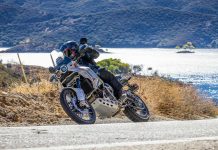Team Green keeps the supersport dream alive with its updated 2024 Kawasaki Ninja ZX-6R, bringing a handful of updates to its faithful 636cc inline-four-powered motorcycle. While Kawi’s Japanese competitors have allowed their offerings to collect over a decade’s worth of dust or disappear from many markets, the ZX-6R enjoyed meaningful tweaks along the way, and the sport segment is all the better for it, we say. Let’s face it, stretching the throttle cable of a 600-class screamer with a properly set up chassis is one of sport motorcycling’s great joys—the Goldilocks horsepower figures and inherent agility go a long way in this class.
To give the 2024 Kawasaki Ninja ZX-6R a proper whirl, we spun laps at Ridge Motorsports Park in Shelton, Washington. The undulating 2.47-mile road course is equally technical and scenic, keeping any supersport rider and machine on their respective toes. And now, without further ado, let’s get on to the Fast Facts.
- A handful of changes come to the 2024 ZX-6R, many of which recognize that these racetrack-born steeds will lead their lives on the streets. This year is another subtle evolution of what’s become the last model standing in the traditional 600cc supersport category, with most of the core components remaining as we know them. Engine tweaks give a nod to road riders by promising additional low and midrange power, the brand’s tried-and-true TFT display paves the way for Bluetooth connectivity and accompanying features, and the middleweight Ninja is fresh-faced with a styling update. The final touches are round front discs instead of petal style, and Pirelli Diablo Rossi IV tires replace Bridgestone Battlax Hypersport S22 rubber.
- A shouty inline-4 screamer engine and stratospheric redline still define the ZX-6R. Initially launched in 2013, the 636cc engine broke from the supersport herd by giving riders an extra three dozen cubes, netting stronger bottom-end shove and midrange motivation. Useable power is made at lower rpm than its classic 600cc competitors, giving this smooth, rev-happy mill a forgiving streak that riders across the board can enjoy. For over a decade, that’s been the ZX-6R powerplant’s defining trait, one that’s still underscored while flipping through areas like The Ridge’s front-straight chicane and off its many technical apexes. Once you’ve cleared the abrupt initial throttle crack, wrangling the 110 or so ponies underneath you is remarkably rewarding and encourages riders to push on gleefully. However, some of its top-end zest is curbed due to Euro 5 conscious updates, as power trails off above 12.5k.
- Engine updates try to balance emissions compliance and performance goals. New intake funnels top the list, followed by new camshaft profiles featuring lower lift and shorter duration (less air/fuel in; less spent gasses out), a redesigned header, and a new O2 sensor location work to meet ever-stringent carbon standards. Coincidentally, these tweaks created an opportunity to revise the fuel map and promote the ZX-6R’s characteristic low-to-midrange punch. Kudos there, as that remains quite present. Nonetheless, these updates detract from a short-stroke inline-4’s greatest strength—top-end power. As noted in the high-revving environment of the racetrack, the drop-off is noticeable; street riders are unlikely to explore those upper regions nearly as often.
- Performance solutions are already available. Without increasing displacement to compensate for heavier restrictions, peak performance is going to take a hit of some kind. It’s a reality that any veteran powerplant faces and hence why many manufacturers opt to toss in larger engines—even the epically longstanding Suzuki Hayabusa is not immune. Graves Motorsports has lent a hand with Kawasaki Motors Corp. USA’s roadracing efforts for several seasons and was on site to answer performance-minded questions while displaying some of the racetrack-only options available. Full-exhaust systems, race-spec cams, velocity stacks, ECU flashes, and more are available for those who want to reclaim that power and beyond on a closed course.

- A sporting gearbox is still part of the program. Nary a bolt was touched in the solid transmission, which utilizes a light-touch slip-and-assist clutch that helps keep things in shape while barreling into hard braking zones and spiking the revs. When it comes time to exit, you’ve got an up-only quickshifter to help you complete shifts. Kill times are too long at faster paces and should be tightened up, and this is where the old-school cable throttle is showing its age. It can’t accept an autoblipper for downshifting—a standard feature on the ZX-4RR and ZX-10R Ninjas.
- Sport, Road, and Rain riding modes adjust your non-cornering traction control (three levels) and engine power modes (full or low). Remember that the throttle map is identical across the board, and a customizable Rider mode is available should you want to disable TC. While the basic TC system functions well, we had tons of grip at our disposal, and it never got in the way. All this is selected on a 4.3-inch TFT dash that Kawasaki has employed its display on several models. The dash also opens the door for modern amenities such as Bluetooth connectivity and its Rideology app. Perfunctory features like riding logs, vehicle information, and mobile notifications join the mix.
- Power meets control in the 2024 Kawasaki Ninja ZX-6R chassis. The course at Ridge Motorsports Park is wickedly fun and physical. With massive elevation changes, fast bits, and tight hairpins, it has everything. The ZX-6R’s athletic geometry figures, in the form of a short wheelbase and steep rake, mean you can get this dexterous supersport pointed in a direction without much effort. Agile? Absolutely. Fortunately, the middleweight Ninja is still planted and withstands being bullied to an apex. Toss in the more than capable fully adjustable Showa suspension, and the Kawi is ready to turn fast laps with a few screwdriver turns. It all speaks to you in blisteringly quick corners and holds true when hard on the binders or gas. Remember that power and chassis parity we mentioned? This is why the supersport class is such a blast.
- The aggressive riding position is born for the track. Clip-ons, rearsets, and tight riding quarters are best sampled at the racetrack, where we can climb around our steeds like jockeys and wrangle them toward every apex. Even when placed on that uncompromising spectrum, the Kawasaki opts for an arguably tighter cockpit. It has a shorter front-to-back seat distance than most, encouraging more weight over the front end, though stuffing my 5-foot-10 frame behind the shallow bubble is a big ask. Kawasaki always seems to get it right with the fuel tank, allowing massive real estate to hang off whilst dragging knees. Ergonomics are personal, which is why adjustable clip-ons and rearsets are appealing.
- While Pirelli Diablo Rosso IV tires are standard, we ran Pirelli Diablo Superbike SC1 slicks at The Ridge. While the sporty yet sensible stock rubber is a grippy tire for the road, or even riders getting their feet wet at the track, we used full-blown slicks. Good tires are worth their weight in gold, and you can’t beat the sheer amount of bite you get from something like the Italian brand’s SC1 slick. The edge grip is immense, so, when coupled with that willing chassis, you have the confidence to fire out of corners as hard as you dare. Interestingly, we stuck with the standard 120/70 and 180/55 sizes instead of upping the rear profile to toss the bike on its nose. The chassis steers quickly enough, though if you want more out of the ZX-6R, shimming the shock to raise the rear ride height is relatively easy.
- The Nissin braking components on the new ZX-6R are up to snuff. A minor change joins the party—round 310mm rotors replace the petal-style discs of yesterday. The same four-pot Nissin calipers are controlled by a radial master cylinder; this was a track test, so we opted for non-ABS models. While not the highest spec in the land, these binders work incredibly well, providing good feedback through the adjustable levers when trailing into corners. A touch of squish can be attributed to the rubber lines, but it’s nothing that a set of steel-braided lines wouldn’t take a whip into shape.
- ABS is a $1000 option. KRT Edition or not, all ABS-equipped 2024 Kawasaki Ninja ZX-6Rs are $12,299. That’s a hefty price for a basic rider aid that doesn’t offer cornering functionality, even though the ABS models feature the latest Bosch 9.3MP unit that claims to provide improved intervention. For the average street rider, I’d still highly recommend it, though track day enthusiasts and racers will want to opt for non-ABS models. We should also note that no IMU is present, so cornering ABS and lean-angle-sensitive TC aren’t available.
- The latest in Ninja trends is on display within the ZX-6R. Okay, so the tail section and tank aren’t new. What is fresh is the front-end bodywork, replete with LEDs all around and slick integrated turn signals. On the lighting note, the headlights worked well as we lapped until the sun dropped behind the hills. The design trends edge towards the latest ZX-10R variant, though I’d argue they push the ball further.
- The 2024 Kawasaki Ninja ZX-6R shows why the supersport class needs to stick around. What struck me most when stepping off the ZX-6R was how good a well-setup supersport can be. The chassis and power harmony are more than encouraging through any high-speed or technical bits at Ridge Motorsports Park. It’s a fantastic feeling, simply put. While the display and styling updates are a nice touch, there’s no denying that salt-and-pepper is showing in the ZX-6R’s beard, what with the 636cc giving up some top-end performance and older electronic features staying put with a price hike. Still, what counts is the sporting ability, which continues to shine through in nearly stock trim. What’s more, its race viability is still present, seeing as the Graves-spec 6Rs are frequent front runners in a field full of Next Generation supersports.
RIDING STYLE
- Helmet: Arai Corsair-X
- Suit: Alpinestars GP Tech V4
- Airbag: Alpinestars Tech-Air 5
- Baselayer: VNM Sport compression top and pant
- Gloves: Alpinestars GP Tech V2
- Boots: Alpinestars SuperTech R
2024 Kawasaki Ninja ZX-6R Specs
ENGINE
- Type: Inline-4
- Displacement: 636cc
- Bore x stroke: 67.0 x 45.1mm
- Compression Ratio 12.9:1
- Maximum torque: 52 ft-lbs @ 11,500 rpm
- Fueling: EFI w/ four Mikuni 38mm throttle bodies
- Transmission: 6-speed w/ quickshifter (upshift only) and Positive Neutral Finder
- Final drive: Sealed chain
CHASSIS
- Front suspension; travel: Fully adjustable Showa Big Piston Separate Function inverted 41mm cartridge fork; 4.7 inches
- Rear suspension; travel: Linkage-assisted fully adjustable Showa shock; 5.9 inches
- Tires: Pirelli Diablo Rosso IV (Pirelli Diablo Superbike SC1, as tested)
- Front tire: 120/70 x 17
- Rear tire: 180/55 x 17
- Front brake: 310mm discs w/ radially mounted 4-piston Nissin monobloc calipers
- Rear brake: 220mm disc w/ single-piston Nissin caliper
- ABS: ABS optional (+$1000)
DIMENSIONS and CAPACITIES
- Wheelbase: 55.1 inches
- Rake: 24.5 degrees
- Trail: 4.1 inches
- Seat height: 32.7 inches
- Fuel tank capacity: 4.5 gallons
- Curb weight: 426 pounds (ABS: 430 pounds)
COLORS
- Metallic Flat Spark Black / Ebony
- Pearl Robotic White / Metallic Graphite Gray
- Lime Green / Ebony (KRT Edition)
2024 Kawasaki Ninja ZX-6R Price: $11,299 MSRP
2024 Kawasaki Ninja ZX-6R Review Photo Gallery
Graves Motorsports 2024 Kawasaki Ninja ZX-6R Photo Gallery
























































![2023 KTM 390 Adventure Review [15 Fast Facts] 2023 KTM 390 Adventure Review: For Sale](https://ultimatemotorcycling.com/wp-content/uploads/2023/10/2023-ktm-390-adventure-review-24-218x150.webp)
![2023 Kawasaki KLR650 S ABS Review [15 Fast Facts]](https://ultimatemotorcycling.com/wp-content/uploads/2023/10/2023-kawasaki-klr650-s-review-dual-sport-adventure-motorcycle-14-218x150.webp)
